Sport(s) Football Spouse Anne Hayes (m. 1942–1987) 1946–1948 Denison | Name Woody Hayes 1933–1935 Denison Children Steven Hayes | |
 | ||
Born February 14, 1913Clifton, Ohio ( 1913-02-14 ) Buried March 14, 1987, Union Cemetery Similar People | ||
Ohio state football woody hayes http www ioffer com i 37873881
Wayne Woodrow "Woody" Hayes (February 14, 1913 – March 12, 1987) was an American football player and coach. He served as the head coach at Denison University (1946–1948), Miami University in Oxford, Ohio (1949–1950), and Ohio State University (1951–1978), compiling a career college football record of 238 wins, 72 losses, and 10 ties.
Contents
- Ohio state football woody hayes http www ioffer com i 37873881
- Woody hayes vs charlie bauman 1978 gator bowl
- Early years
- Coaching at Denison and Miami University
- Ohio State
- Controversies
- 1962 Rose Bowl vote
- Comments on the My Lai Massacre
- Confrontation with Jerry Markbreit
- 1978 Sugar Bowl
- 1978 Gator Bowl incident and dismissal
- Final days and death
- Legacy
- Personal life
- World War II movie host
- Coaching tree
- References
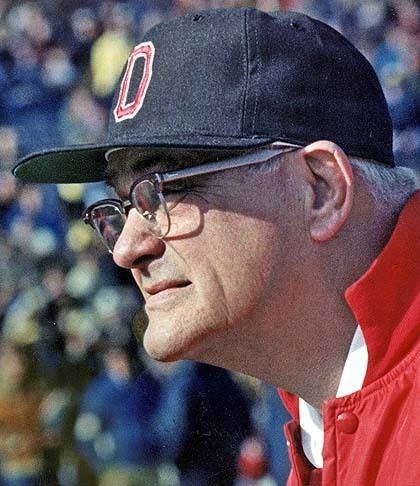
During his 28 seasons as the head coach of the Ohio State Buckeyes football program, Hayes' teams won five national championships (1954, 1957, 1961, 1968, 1970), captured 13 Big Ten Conference titles, and amassed a record of 205–61–10. Over the last decade of his coaching tenure at Ohio State, Hayes's Buckeye squads faced off in a fierce rivalry against the Michigan Wolverines coached by Bo Schembechler, a former player under and assistant coach to Hayes. During that stretch in the Michigan–Ohio State football rivalry, dubbed "The Ten Year War", Hayes and Schembechler's teams won or shared the Big Ten Conference crown every season and usually each placed in the national rankings.

Despite his great achievements at Ohio State, Hayes's coaching career ended ignominiously when he was dismissed from the University after punching Clemson middle guard Charlie Bauman for intercepting an Ohio State pass with two minutes left on the clock in the 1978 Gator Bowl. He was inducted into the College Football Hall of Fame as a coach in 1983.
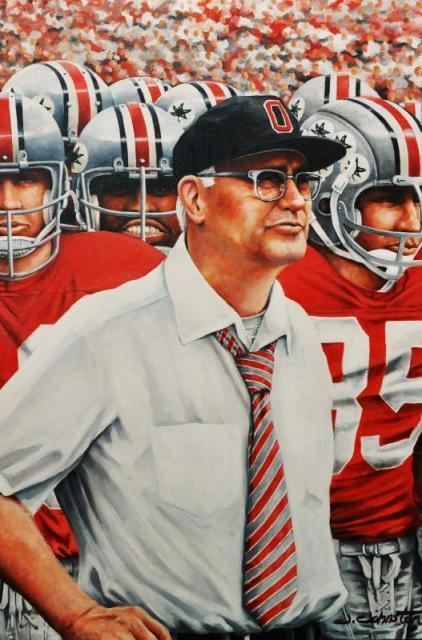
Woody hayes vs charlie bauman 1978 gator bowl
Early years
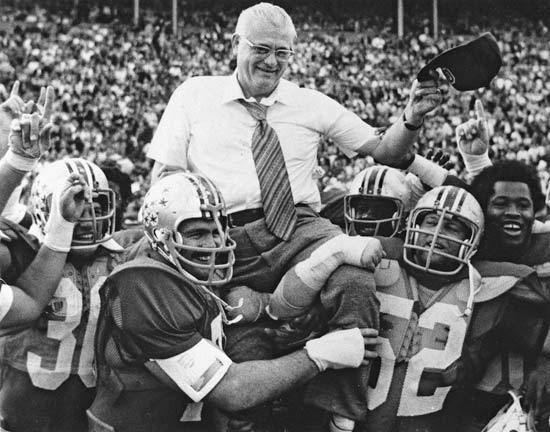
A native of Clifton, Ohio, Hayes was the youngest of three children born to Wayne B. and Effie (née Hupp) Hayes. He played center at Newcomerstown High School in Newcomerstown, Ohio. At Denison University, he played tackle under coach Tom Rogers, and was a member of Sigma Chi fraternity. After graduating from Denison in 1935, Hayes went on to serve as an assistant at two Ohio high schools: Mingo Junction in 1935–1936 and New Philadelphia in 1937. When New Philadelphia head coach John Brickels left to accept another position, Hayes was elevated to the head coaching position, where he put together a 17–2–1 record in his first two seasons before enduring a 1–9 record in 1940.
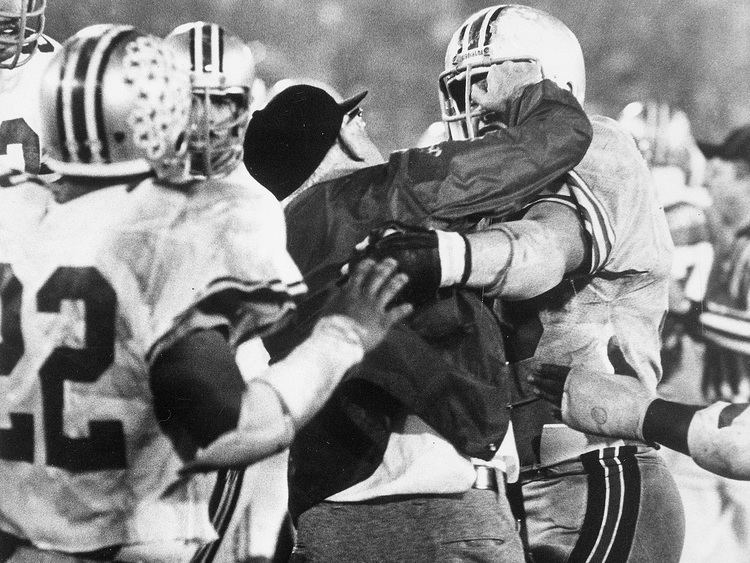
Hayes enlisted in the United States Navy in July 1941, eventually rising to the rank of Lieutenant Commander during World War II. He commanded PC 1251 in the Palau Islands invasion and the destroyer-escort USS Rinehart in both the Atlantic and Pacific operations.
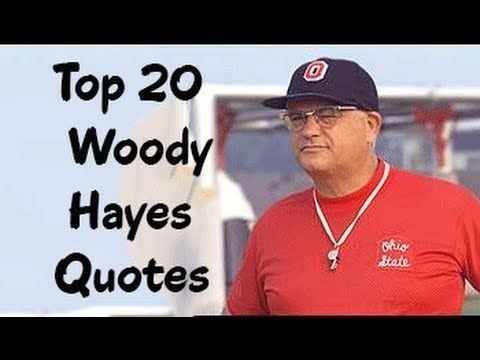
As World War II was winding down and Hayes' alma mater, Denison University, was pursuing plans to reinstate its football program (which had been suspended during the war), it contacted former head coach Rogers (also in the Navy) about rejoining the program as head coach. Rogers declined, but recommended that his former team captain, Hayes, be named the next head coach. Denison was able to locate and cable Hayes an offer, which he accepted, minutes before his Navy ship was to begin the passage through the Panama Canal — meaning Hayes would have been incommunicado for an extended period of time.
Coaching at Denison and Miami University
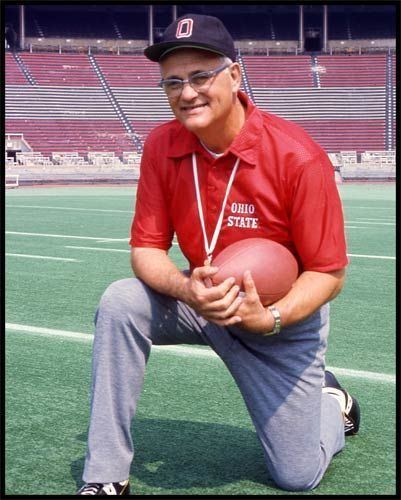
Upon returning to Denison in 1946, Hayes struggled during his first year, winning only two games, over Capital and the season finale against Wittenberg. However, that victory sparked a 19-game winning streak, a surge that propelled him into the head coaching position at Miami University. Miami is recognized as the "Cradle of Coaches" because of its history of outstanding coaches starting their careers there, such as Paul Brown, Ara Parseghian, Weeb Ewbank, Bill Mallory, Sid Gillman, Randy Walker, and Bo Schembechler. Gillman was Hayes' immediate predecessor at Miami before Gillman moved down the road to coach at the University of Cincinnati, which was then Miami's chief rival. Hayes and Gillman maintained a fierce rivalry between themselves, combining mutual distaste for the other's coaching style and because they were in recruiting competition in the same general area.
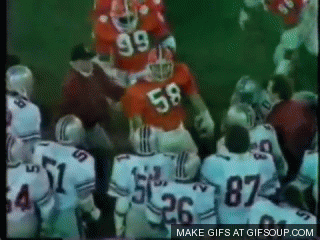
In his second year with the Miami Redskins, Hayes led the 1950 squad to an appearance in the Salad Bowl, where they defeated Arizona State University. That success led him to accept the Ohio State head coaching position on February 18, 1951, in a controversial decision after the university rejected the applications of other more well-known coaches, including former Buckeyes' head coach Paul Brown, incumbent Buckeye assistant Harry Strobel and Missouri head coach Don Faurot.
Ohio State
As head coach of the Ohio State Buckeyes, Hayes led his teams to a 205–61–10 record (.761), including three consensus national championships (1954, 1957 and 1968), two other non-consensus national titles (1961 and 1970), 13 Big Ten conference championships, and eight Rose Bowl appearances. Hayes was a three-time winner of The College Football Coach of the Year Award, now known as the Paul "Bear" Bryant Award, and was "the subject of more varied and colorful anecdotal material than any other coach past or present, including fabled Knute Rockne", according to biographer Jerry Brondfield.
Hayes' basic coaching philosophy was that "nobody could win football games unless they regarded the game positively and would agree to pay the price that success demands of a team." His conservative style of football (especially on offense) was often described as "three yards and a cloud of dust"—in other words, a "crunching, frontal assault of muscle against muscle, bone upon bone, will against will." The basic, bread-and-butter play in Hayes' playbook was a fullback off-guard run or a tailback off tackle play. Hayes was often quoted as saying "only three things can happen when you pass (a completion, an incompletion, and an interception) and two of them are bad."
In spite of this apparent willingness to avoid change, Hayes became one of the first major college head coaches to recruit African-American players, including Jim Parker, who played both offensive and defensive tackle on Hayes' first national championship team in 1954. While Hayes was not the first to recruit African-Americans to Ohio State, he was the first to recruit and start African-Americans in large numbers there and to hire African-American assistant coaches.
Another Hayes' recruit, Archie Griffin, remains the only two-time Heisman Trophy winner in seven decades of selections. Altogether Hayes had 58 players earn All-America honors under his tutelage. Many notable football coaches, such as Lou Holtz, Bill Arnsparger, Bill Mallory, Dick Crum, Bo Schembechler, Ara Parseghian and Woody's successor, Earle Bruce, served as his assistants at various times.
Hayes would often use illustrations from historical events to make a point in his coaching and teaching. When Hayes was first hired to be the head coach at OSU, he was also made a "full professor of physical education", having earned an M.A. degree in educational administration from Ohio State in 1948. The classes that he taught on campus were usually full, and he was called "Professor Hayes" by students. Hayes also taught mandatory English and vocabulary classes to his freshman football players. One of his students was a basketball player named Bobby Knight, who was to become a legendary basketball coach.
During his time at Ohio State, Hayes' relationships with faculty members were particularly good. Even those members of the faculty who believed that the role of intercollegiate athletics was growing out of control respected Hayes personally for his commitment to academics, the standards of integrity with which he ran his program, and the genuine enthusiasm he brought to his hobby as an amateur historian. Hayes often ate lunch or dinner at the university's faculty club, interacting with faculty and administrators.
As a coach and an educator, Hayes was one of the first to use the motion picture as a teaching and learning tool. He was also memorable in that he could be seen walking across campus, taking the time to visit with students. When talking to young people, Hayes treated all with respect, without regard to race or socio-economic class. This behavior by Hayes was helpful to Ohio State to quell the violence and damage from anti-war demonstrations that other college campuses suffered in the late 1960s and early 1970s. He would actually take the time to communicate with student leaders. Then-team quarterback Rex Kern said, "Woody was out there on the Oval with the protesters, and he'd grab a bullhorn and tell the students to express their beliefs but not be destructive. He believed in Nixon, and he believed in the Establishment, but he wasn't afraid to talk to the students. He wanted to stay close to the action." Hayes was considered one of the few authority figures that students then had respect for. His enthusiasm for coaching and winning was such that many across the nation consider the following maxim to be true: "What Vince Lombardi was to professional football, Woody Hayes was to college football."
During his tenure at Ohio State, Hayes would joke that he considered himself to be Notre Dame's best recruiter because if he could not convince a recruit to come to Ohio State instead of Michigan he would try to steer the recruit to Notre Dame, whom Ohio State did not play. While Hayes' public stance was that he refused to play Notre Dame because he was afraid of polarizing the Catholic population in Ohio, Notre Dame's long-time athletic director Edward "Moose" Krause said that Hayes had told him that Hayes liked having Michigan as the only tough game on the Ohio State schedule and that having the Buckeyes play Notre Dame would detract from that. Despite Hayes' apparent fear of playing more than one "tough" game a year, Ohio State still managed to schedule regular-season games with Nebraska, Washington, Southern California, UCLA, and Oklahoma during his tenure.
After losses or ties, Hayes would conduct locker room interviews while naked. A journalist from his tenure noted, "He was an ugly guy so it would clear the locker room out pretty fast."
Controversies
In 1959, following a 17−0 loss to USC, Hayes threw a punch at Los Angeles Examiner sportswriter Al Bine, but missed, and punched the brother of Pasadena Independent sports editor Bob Shafer in the back instead. In a May 1965 meeting of Big Ten Conference athletic directors and coaches, Hayes nearly started a fight with Iowa's athletic director, Forest Evashevski, before being restrained.
In 1968, Hayes team won a game against rival Michigan, 50–14. Late in that game, Ohio State held a commanding 44–14 advantage and scored one final touchdown. Rather than taking the more common extra point kick, Hayes instead opted for a two-point conversion (which was unsuccessful), leading many football fans to believe that Hayes was running up the score. When asked later why he went for two points, Hayes said, "Because I couldn't go for three!"
Prior to the 1973 Rose Bowl, Hayes shoved a camera into the face of a news photographer; Hayes was suspended for three games, fined $2,000, and left California with a subpoena.
In 1977, a late fumble at Michigan caused him to charge at ABC cameraman Mike Freedman, who recorded his frustration; Hayes was ejected, put on probation by the Big Ten Conference, and fined $2,000.
1962 Rose Bowl vote
In the 1961 season Ohio State won the Big Ten championship, qualifying automatically for the Rose Bowl. At the time, the Big Ten Conference rules stated that the school's Faculty Council must officially approve of the trip. In this unusual development, the Ohio State Faculty Council voted 25 to 28 against the 1962 Rose Bowl trip, prompted by the head of a university alumni group, on the grounds that the school's academic reputation was suffering because of over-emphasis on the football team. Other reports state that the bid was declined because Ohio State had already beaten their would-be Rose Bowl opponent, UCLA, during the regular season. The decision sparked minor rioting on the Ohio State Campus and in the Columbus area. The Columbus Dispatch published the names, addresses, and phone numbers of those Faculty Council Members who voted against the trip as well as the amount of university money that they spent on trips. While Hayes was diplomatic with some faculty members who voted against the trip and urged the students to cease complaining, he did not spare his criticism of the alumni club president who led the charge against accepting the bowl bid.
Comments on the My Lai Massacre
Speaking at a football banquet in 1969, Hayes spoke about the recently revealed My Lai Massacre. He stated that the Vietnamese men in My Lai deserved to die, "and I wouldn't be so sure those women were innocent. The children are obviously innocent – if they are less than five."
Confrontation with Jerry Markbreit
Late in the 1971 rivalry game against Michigan in Ann Arbor, furious over what he thought was a missed defensive pass interference foul committed by Thom Darden of Michigan, Hayes stormed onto the field, launched a profanity-laced tirade at referee Jerry Markbreit, and tore up the sideline markers, receiving a 15-yard unsportsmanlike-conduct penalty. Hayes then threw the penalty flag into the crowd, began destroying the yard markers, and threw the first-down marker into the ground like a javelin before being restrained by Buckeyes team officials; Hayes was then assessed an additional 15-yard penalty and ejected. Hayes was suspended for one game and fined $1,000. As of 2017, Hayes is the only coach in football history to be ejected from a game, as coaches in football do not usually get ejected.
1978 Sugar Bowl
The 1978 Sugar Bowl was the only time that Woody Hayes and Bear Bryant had coached against each other. Bear Bryant's Alabama Crimson Tide beat Woody's Buckeyes by a score of 35-6.
1978 Gator Bowl incident and dismissal
On December 29, 1978, the Buckeyes played in the Gator Bowl against the Clemson Tigers. Late in the fourth quarter, the Tigers were leading the Buckeyes 17–15. Freshman quarterback Art Schlichter directed the Buckeyes into field goal range. On 3rd and 5 at the Clemson 24-yard line with 2:30 left and the clock running, Hayes called a pass rather than a run, because Schlichter was having a great game up to that point.
The pass was intercepted by Clemson nose guard Charlie Bauman, who returned it toward the OSU sideline where he was run out of bounds. After Bauman got back up, Hayes punched him in the throat, triggering a bench-clearing brawl. Hayes stormed onto the field and was abusive towards the referee. When one of Hayes' own players, offensive lineman Ken Fritz, tried to intervene, Hayes turned on him, and had to be restrained by defensive coordinator George Hill. The Buckeyes were assessed two 15-yard unsportsmanlike conduct penalties for Hayes' attack on Bauman and his abuse towards the referee. Bauman was not injured by Hayes' punch and shrugged the incident off. Even though the game was being telecast by ABC, announcers Keith Jackson and Ara Parseghian did not comment about the punch. (At the time, all non-press box cameras were operated remotely from another site, and Keith did not actually witness the punch, his view of the sideline's being blocked by the upper tier of the stadium).
After the game, OSU Athletic Director Hugh Hindman, who had played for Hayes at Miami of Ohio, and had been an assistant under him for seven years, privately and furiously confronted Hayes in the Buckeye locker room. He said that he intended to tell school president Harold Enarson about what happened, and strongly implied that Hayes had coached his last game at Ohio State. After a heated exchange, Hindman said he then offered Hayes a chance to resign, but Hayes refused, saying, "That would make it too easy for you. You had better go ahead and fire me." Hindman then met with Enarson at a country club near Jacksonville, and the two agreed that Hayes had to go.
The next morning, Hindman told Hayes that he had been dismissed and relieved of his coaching duties at OSU. A press conference was held at the hotel where the team had been staying. The team returned to Columbus around noon, and Hayes left the airport in a police car. Regarding Hayes' dismissal, Enarson said that "there isn't a university or athletic conference in this country that would permit a coach to physically assault a college athlete." After the incident, Hayes reflected on his career by saying, "Nobody despises to lose more than I do. That's got me into trouble over the years, but it also made a man of mediocre ability into a pretty good coach." About two months after the incident, Hayes called Bauman in his dorm room, but did not apologize for his previous attack on him. Earle Bruce succeeded Hayes as head football coach at Ohio State University.
Many years later, Leonard Downie, Jr., former executive editor of The Washington Post and student journalist at Ohio State, said he regretted not reporting an incident in the 1960s where Hayes instructed a player to take off his helmet and then hit him in the head.
According to the 1994 HBO documentary American Coaches: Men of Vision and Victory, Hindman had placed Hayes on notice at the beginning of the 1978 season, not just for the swing at the ABC cameraman during the 1977 Michigan game, but also for hitting a player during a practice. In his 1989 autobiography, Michigan's Bo Schembechler wrote that he believed Hayes, who was diabetic and may have had a high blood sugar level, didn’t believe he struck Bauman. Schembechler also pointed out that Hayes had maintained that all he was trying to do was grab the ball away.
Before and after the dismissal incident, Hayes was a professor of Military History at Ohio State. His office was in the ROTC building, Converse Hall, across the street from Ohio Stadium. For the remainder of his years at OSU, he continued to teach and mentor students.
Final days and death
On March 11, 1987, Hayes was clearly in failing health when he had someone drive him in his pickup truck to Dayton to introduce Schembechler, who was speaking at a banquet. Organizers had tried to discourage Hayes from attending, but Hayes insisted. He gave a lengthy introduction to Schembechler and then stayed to hear him speak before being driven back home.
The next morning, March 12, Hayes's wife Anne found him dead in his bed at the couple's home. He died of a heart attack at age 74. He is interred at Union Cemetery in Columbus, Ohio.
Legacy
Hayes's lifetime record of 238–72–10 placed him ninth in all-time NCAA Division I FBS coaching victories. He was inducted into the College Football Hall of Fame in 1983.
At Hayes's funeral at First Community Church in Grandview, Ohio on March 17, 1987, former president Richard Nixon delivered the eulogy before a crowd of 1,400, acknowledging the friendship that had begun between the two during his second term as vice president. Having met Hayes at a reception following a Buckeye win over Iowa in 1957, Nixon recalled, "I wanted to talk about football. Woody wanted to talk about foreign policy. And you know Woody—we talked about foreign policy." The following day, more than 15,000 people took part in a memorial service at Ohio Stadium.
Hayes's commitment to academics at Ohio State was evidenced by his request that donations from his family, friends, and supporters be made to the academic side of the university. Following his death and in keeping with his wishes, the Wayne Woodrow Hayes Chair in National Security Studies was established at Ohio State's Mershon Center for International Security Studies. Professor John Mueller currently holds the chair. In November 1987, the university dedicated the new Woody Hayes Athletic Center in his memory.
Personal life
Hayes married the former Anne Gross in 1942. Anne Hayes was a formidable and popular woman in her own right, who used to jokingly say at numerous sports banquets, "Divorce Woody? Never! But there were plenty of times I wanted to murder him!" The couple had one son, Steven, who went on to become a lawyer and judge. Coincidentally, the younger Hayes would be assigned to the 2003 trial of former Ohio State standout Maurice Clarett.
World War II movie host
Because of his knowledge of military history and ongoing popularity, Hayes in the early 1980s hosted the broadcast of six World War II films for WBNS-TV in Columbus, which has served as the official outlet of Ohio State sports media programming for years, including the football coach's shows. Among the movies broadcast were Patton, Midway, The Wackiest Ship in the Army, The Desert Fox: The Story of Rommel, and Tora! Tora! Tora!
Hayes would also give salty historical perspectives related to each movie. Hayes' segments, depending upon the movie, were taped in such locations as Fort Knox, West Point, the USS Yorktown, and Stuttgart, Germany, where he interviewed Manfred Rommel, Lord Mayor of Stuttgart and the son of Erwin Rommel.
Coaching tree
Former assistants who became NCAA Division I FBS or NFL head coaches:
Former players who became assistants who became NCAA Division I FBS or NFL head coaches:
Former players who became NCAA Division I FBS or NFL head coaches:
